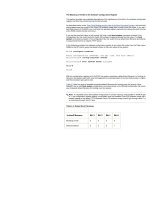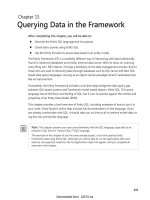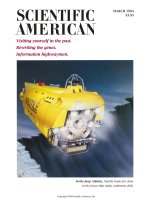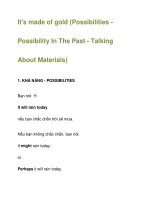Unit4Life in the past
Bạn đang xem bản rút gọn của tài liệu. Xem và tải ngay bản đầy đủ của tài liệu tại đây (142.15 KB, 12 trang )
<span class='text_page_counter'>(1)</span>PERIOD 26 / WEEK 9. Unit 4: LIFE IN THE PAST Lesson 1 - GETTING STARTED: Preserving the past I. OBJECTIVES: By the end of this lesson, students will be able to: use the lexical items related to life in the past II . PREPARATION: sub -board, pictures, cassette III. PROCEDURES: Teacher’s and students’ activities. Content. Activity 1: 1 Ask Ss to look at the title of the conversation and the picture. Ask them some questions: • What do you think the people in the conversation are talking about? • How do you understand the title ‘Preserving the past’? Ss answer the questions as a class. Play the recording and have Ss follow along. a./ Ss work independently. Encourage them to answer the Key: questions without looking back at the conversation. Then 1.Fathers make kites for sons. allow Ss to share answers. Check their answers as a class. 2.Once every two months. 3.They used to come early, trying to get a place near the screen. 4.Only wealthy households. 5.Yes, he does. He said: “Sometimes I wish I could go back to that time. b./ Ask Ss to find the expressions in the conversation and read Key: the context where they appear to make sure that they understand 1.c 2.a 3. d 4.b the meanings of the expressions correctly. Ss then do the matching. Correct the answers as a class. Ask Ss if they can think of some more expressions with the same meaning. Key: c./ Have Ss work independently to find the most suitable 1. Sure. 2.I can’t imagine that. response to each item. Ss can then exchange their answers. T 3.How cool! checks as a class and explains the answers where necessary. 4.I wish I could go back to that time. 5. How cool! 6.I can’t Activity 2: imagine that. Make sure Ss understand the meaning of the words/phrases in Key: the box. T can ask them to give some examples to show that 1.a 2. d 3.c 4. b 5. e 6. they understand the phrase ‘technological changes’. Ss then F work independently to complete the sentences. Have them share their answers in pairs. Then elicit the answers from the whole class. Activity 3: Example: Women in Hue used.
<span class='text_page_counter'>(2)</span> Have Ss work in small groups to come up with as many past events and practices in their areas as possible. Give the groups a time limit, for example, five minutes. Have them present the list they have made to the class. As a whole class, decide if these practices were specific to their region or neighbourhood or were also practised elsewhere.. IV- HOMEWORK: -Practice reading the dialogue. -Write new words then learn them by heart. -Copy the exercise into notebooks. -Prepare A CLOSER LOOK 1 . PERIOD 27 / WEEK 9. to go swimming at the beach fully clothed, to wear palm leaf conical hats, to wear the traditional long dress whenever they went out, to stay at home as housewives, ....
<span class='text_page_counter'>(3)</span> Unit 4: LIFE IN THE PAST Lesson 2 – A CLOSER LOOK 1 I. OBJECTIVES: By the end of this lesson, students will be able to: identify in which situations to stress auxiliary verbs in sentences and say these sentences correctly use used/didn’t use + to-infinitive to talk about past practices II . PREPARATION: sub -board, pictures, cassette III. PROCEDURES:. Teacher’s and students’ activities. Grammar Activity 1: Ask Ss to do the matching individually. Then allow them to share their answers with a partner. Check as a class. Note: Ss might have difficulty with the meaning of ‘act out stories’, ‘go bare-footed’, and ‘dance to drum music’. To check comprehension, T can ask Ss to mime activities to ensure everyone has a thorough understanding of the phrases. Activity 2: Ss work individually or in pairs. Ask them to choose the correct answer for each sentence first. They then read the sentence carefully to determine the form and the tense of the verb. Check the answers as a class. Content Key: 1.f 2.g 3.b 4.a 5. c 6.e 7. h 8.d. Key: 1.kept a diary 2. entertain themselves 3.preserve our traditions 4.Use your imagination 5.acting out stories 6. collect the post 7. going bare-footed 8. dance to drum music Key: Activity 3: Have Ss work individually. Then they can exchange 1.seniority 2.illiterate 3.street their answers with a partner. Check as a class. Now ask vendors for volunteers, or select Ss, to make new sentences 4.strict rules 5. Physical 6.face to face using these words and phrases. Let the rest of the class decide whether the sentence makes sense or not. Try to give lots of Ss a go, not just the ones who are the most extrovert in the class. Activity 4: These words have similar meanings. Before doing the Key: 1.habit 2.behaviour 3.tradition task, ask Ss to cover the REMEMBER! box and elicit the definitions if possible. Then allow them to read the 4. habit 5. practice 6. Behaviour definitions before doing the task. Have Ss read each sentence and decide what part of speech is missing from the sentence. For example, sentence 1 needs a noun because this word stands after article ‘a’. They then complete all the sentences. Confirm the correct answers as a class. Key + Audio script: Activity 5: Ask Ss to note all the auxiliaries they find in the 1. Life will be improved in those sentences first. Discuss with them which ones they think remote areas..
<span class='text_page_counter'>(4)</span> will be stressed. Play the recording. Ss listen and 2.They can see the rain coming in underline the stressed auxiliaries. They then repeat the from the west. sentences with a focus on the stressed ones. 3.You did make me laugh! Since Ss often see auxiliaries as unstressed, it is a good 4.He hasn’t handed in his assignment. idea to give Ss some initial guidance from the 5. I don’t like the idea of going there REMEMBER! box under exercise 5before they actually at night. do the exercise. 6.Sam doesn’t like fast food but I do Key + Audio script: Activity 6: 1.- The men in my village used to Have Ss work individually to stress the auxiliaries. Ask catch fish with a spear. them to refer to the REMEMBER! box as they do the - Could you do that? exercise. Then play the recording. Ss listen, check, - No, I couldn’t. and say the sentences. Call on some Ss to say the 2. I have told you many times not to sentences individually. leave the door open. 3. We’re going to visit Howick, a historical village. 4. - You aren’t going to the party? Is it because you can’t dance? - I can dance. Look! 5. - I hope she doesn’t do any damage to the car. - Don’t worry. She does know how to drive. IV- HOMEWORK: -Write new words then learn them by heart. -Copy the exercise into notebooks. -Prepare A CLOSER LOOK 2 . PERIOD 28/ WEEK 10. Unit 4: LIFE IN THE PAST.
<span class='text_page_counter'>(5)</span> Lesson 3 -. A CLOSER LOOK 2. I. OBJECTIVES: By the end of this lesson, students will be able to: use used/didn’t use + to-infinitive to talk about past practices express wishes for the present II . PREPARATION: sub -board, pictures, cassette III. PROCEDURES: Teacher’s and students’ activities Activity 1: Have Ss underline the sentences containing used to/didn’t use to + infinitive in the conversation in GETTING STARTED. Ask them to choose the correct answer A, B, or C. T may write the rule on the board as a reminder for Ss as they do exercise 2. Activity 2: Have Ss work individually. Then ask them to exchange their answers. Correct them as a class. Content Key: B. Key: 1.used to be 2.didn’t use to transport 3. used to dye 4. used to kill 5. used to pull out 6.didn’t use to spend Key: 1.for the present 2.the past simple and past continuous. Activity 3: Ask Ss to read the conversation in GETTING STARTED again and look for sentences containing wish. Ask them to underline the main verbs in the sentences and answer the questions. Elicit the rule for the main verbs in the wish sentences for the present. Then have them read the Look out! box. T may write the rule on the board. Activity 4: Key: Have Ss do this exercise individually. They may refer to Correct: 1 and 4 the rule on the board. T checks the answers as a class. Incorrect: 2. will →would 3.can →could 5. don’t →didn’t 6.is →was/were Activity 5: Key: Have Ss look at the prompts first and decide whether the 1. I wish we could communicate with sentence is a wish for the present/future or for animals. something happening right at that moment. They then 2. I wish no child was/were suffering choose the appropriate tense for each sentence. from hunger. Once they have done this, ask them to write out the 3.I wish I was/were playing on the sentences in full. If time allows, let Ss share their work beach. with their partner. T checks as a class. 4.I wish there was/were/would be no more family violence in the world. 5.I wish I was/were going bushwalking with my friends. 6. I wish there were four seasons in my area. IV- HOMEWORK:.
<span class='text_page_counter'>(6)</span> -Write new words then learn them by heart. -Copy the exercise into notebooks. -Prepare COMMUNICATION. . PERIOD 29 / WEEK 10. Unit 4: LIFE IN THE PAST Lesson 4 - COMMUNICATION I. OBJECTIVES:. By the end of this lesson, students will be able to:.
<span class='text_page_counter'>(7)</span> make comments on or express opinions about facts in the past II . PREPARATION: sub -board, pictures, cassette III. PROCEDURES: Teacher’s and students’ activities Content Activity 1: a./ T can start this session by writing ‘Looking Back’ on the board and leading Ss through the discussion of the questions. Encourage Ss to give any or all ideas. There are no wrong answers at this stage. b./ Before Ss read the passages, check their understanding of the words in the Extra Vocabulary box by drawing simple pictures, giving definitions or examples of usage. Have Ss read the passages individually as quickly as possible. Then refer to their answers in 1aand see if their guesses are correct. Activity 2: Key: Have Ss read the definitions and look for the 1.illiterate 2. pass on 3.treat words in each story. They may do this individually or (someone) 4.block 5. survive in pairs. 6.dogsled Activity 3: This task encourages Ss to use their critical thinking skills to find explanations for the questions. Ss will consequently gain a deeper understanding of what life was like for these people. Have Ss work in groups. Encourage them to use their imagination and background knowledge to explain some information from the stories. Ss then share their opinions with the class. T acts as a facilitator.. Activity 4: Have Ss work in groups to match the responses with the stories. Ask them to underline the key words in the responses which help them do the matching. Activity 5: Ask Ss to work in small groups and work out a story of their own. Make sure Ss include the necessary information in the story as suggested in the task. Each group then presents the story to the class. The rest. Suggested answers: 1.It was difficult to reach the villagers on the mountain./There were no other means of transport available. 2. There was no school in the villages./The nearest school might be too far away. 3. There were no other materials available in that deserted land./There were no easy means to transport materials from other places to the island. 4.It was impossible to build a big house with several rooms in the ice and snow./People felt safer living in communal groups Key: Story 1:2, 4 Story 2:1, 3, 5.
<span class='text_page_counter'>(8)</span> of the class can ask questions about the topic. IV- HOMEWORK: -Write new words then learn them by heart. -Copy the exercise into notebooks. -Prepare SKILLS 1. . PERIOD 30 / WEEK 10. Unit 4: LIFE IN THE PAST Lesson 5- SKILLS 1 I. OBJECTIVES: By the end of this lesson, students will be able to: read for specific information about school life in the past make comments on or express opinions about facts in the past II . PREPARATION:.
<span class='text_page_counter'>(9)</span> sub -board, pictures, cassette III. PROCEDURES:. Teacher’s and students’ activities. Content. Reading Activity 1: Brainstorm how teens entertained themselves in the past compared to the present. Make notes of the activities in two lists and leave them on the board while the class reads the conversation in2. Activity 2: Have Ss read the conversation individually and answer Key: 1.They used to play outdoors, in the the questions. Check Ss’ answers as a class. Ask Ss to show where the information for each answer appears fresh air. 2.They met and talked face-to-face. Speaking 3.It kept them healthy and in shape. Activity 3: Ask Ss to read the example in 3and the expressions for 4.At home. opinions and comments in the REMEMBER! box at 5.You had to use your own the bottom of the page. Once they are clear about imagination. what they have to do, they can read each pastime in 6.No, they didn’t. the list and discuss what they think about it in groups of three or four. T should move around the groups and offer guidance. Activity 4: Apart from expressing an opinion on a practice in the past, Ss have to decide whether they would like to keep the practice alive and explain why. Allow Ss some time to read the practices, make their decision, and think of the reasons for their choice. They can then start their discussion. T moves around the class to facilitate the discussions. If something interesting is expressed, T may wish to bring the whole class together to discuss it. IV- HOMEWORK: -Write new words then learn them by heart. -Copy the exercise into notebooks. -Prepare SKILLS 2 PERIOD 31 / WEEK 11. Unit 4: LIFE IN THE PAST Lesson 6 – SKILLS 2 I. OBJECTIVES: By the end of this lesson, students will be able to: listen for specific information about school life in the past write a description of how children in the past studied without technology II . PREPARATION: sub -board, pictures, cassette III. PROCEDURES:. Teacher’s and students’ activities. Listening. Content Key:.
<span class='text_page_counter'>(10)</span> Activity 1: Ask Ss to look at the old photo and read the introduction to the listening and the questions. T may even decide to do a prediction task by asking Ss to guess if each statement is true or false before listening. T then plays the recording and Ss tick (√) the answers. T can play the recording at least twice. Elicit the answers from Ss. Ask them to explain their answers. Confirm the answers as a class. Activity 2: - Have Ss read the questions first to determine which information they need to fill the blanks. Ss then listen to the recording again and write their answers. T checks the answers as a class. WRITING -Activity 3 Ss may work in groups of three or four. Together they make a list of the facilities they are using for their studies. They then tick the ones they think were not available about twenty years ago. T may have the groups write their lists on board. Leave the list there for 4. Activity 4: Ss work individually, referring to the framework while they are writing. If time allows, T can ask some Ss to share their writing with the class.. 1.F 2.T 3. T 4. NG 5.F 6. T. Key: 1. 15 2.bare-footed 3. maths, history (in any order) 4.strict rules 5.extra classes Sample writing: It is most likely that students twenty years ago were not able to enjoy the Internet in their studies. That’s why it took them a lot of time, energy, and even money, to do a project that we can now easily complete in one or two days. For example, when being asked to write an assignment about past habits, the students had to go to the library, look for books on the topic, read the books, and hand-write any information that they thought was useful for their assignment. They would also have to meet with some old people and talk to them about the past. At home, they had to handwrite their assignment, possibly with a lot of erasing and rewriting of the first draft. After fi nishing the draft, they had to write a clean copy on another piece of paper for submission.. IV- HOMEWORK: -Write new words then learn them by heart. -Copy the exercise into notebooks. -Prepare LOOKING BACK PERIOD 32 / WEEK 11. Unit 4: LIFE IN THE PAST Lesson 7 – LOOKING BACK & PROJECT I. OBJECTIVES: By the end of this Unit, students will be able to: Use some vocabularies and structures to talk about related to life in the past II . PREPARATION: sub -board, pictures, cassette III. PROCEDURES:.
<span class='text_page_counter'>(11)</span> Teacher’s and students’ activities Activity 1: Have Ss complete this exercise individually. Check their answers as a class Activity 2: a./Ss work individually. They can then check with their partner. Confirm the correct answers b./ Have Ss complete this exercise individually. Check their answers as a class. Grammar Activity 3: Ss complete this task independently or in pairs. Discussion may sometimes be necessary to decide if a thing was/was not practised in the past. Only then can they form the correct answers. Check as a class.. Content Key: 1. B 2. A 3.C 4. A 5.B. Key: 1. b 2. e 3. a 4.c 5.d Key: 1.acting out 2. die out 3.preserve 4. collecting 5.entertains 1.Men used to be the bread winner of the family. 2.Women didn’t use to go to work. 3.People didn’t use to travel on holiday. 4.Families didn’t use to be nuclear. 5.People used to make banh chung at Tet themselves. 6.Children used to play outdoor games.. Activity 4: Suggested answers: Have Ss complete the exercise independently. Have 1.I wish my village had access to them share their wishes with the class. clean piped water. 2.I wish there was/were a bridge over the river, so we did not have to cross the river by boat twice a day to school. 3. I wish there was/were an organisation for social activities for teenagers in my town. 4. I wish I was/were tall enough to play basketball. 5.I wish there were four seasons in my area./ I wish we had spring and autumn in my area. Activity 5: Suggested answers: Encourage Ss to use their imagination and work out 1.I wish it would stop raining. wishes for the situation. Have them share their 2.I wish the wind weren’t blowing so answers with the class. hard. 3.I wish the sun were shining. 4. I wish I were sitting in a warm house. Communication Key: Activity 6: Order: 1-4-5-2-9-7-8-6-3 Ss work in pairs or small groups to complete the exercise. Check as a class. Then they can practise the.
<span class='text_page_counter'>(12)</span> conversation with their best pronunciation and fluency. Project: Preserving the past This project aims to encourage Ss to do more research about the past with a focus on traditions and habits which are dying out. Divide Ss into groups of four to five and instruct them on what they have to do. Encourage them to interview previous generations – either members of their family or neighbours. Tell them to - choose the pastime they most appreciate and would most like to preserve - explain their choice - work on a plan of how they can help to preserve it Have Ss present their posters in the next lesson. When all the groups have given their presentations, the whole class can vote for the best. IV- HOMEWORK: -Write new words then learn them by heart. -Copy the exercise into notebooks. -Prepare for a 15-minute-test .
<span class='text_page_counter'>(13)</span>









